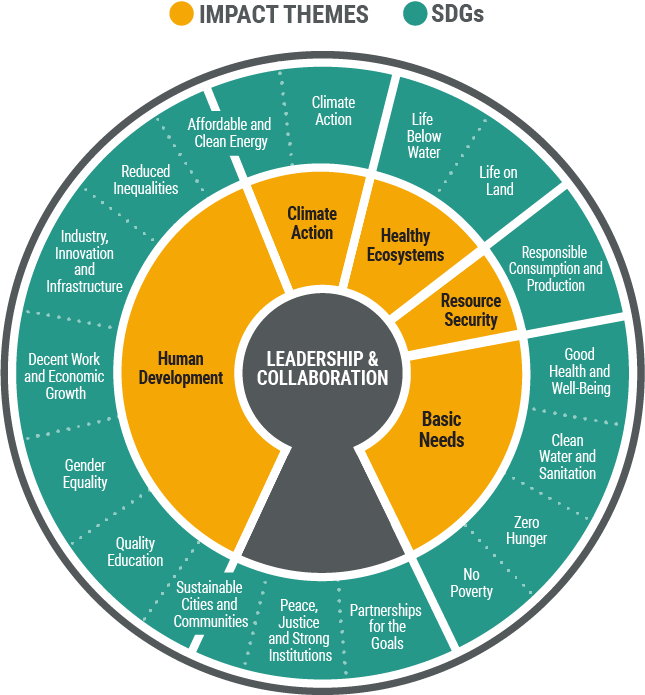Today, there are 2 billion people without easy access to safe drinking water.1 Within the context of global resource security, water security is a crucial challenge as only 3% of the planet’s water is fresh (drinkable). Of the 3%, 2.5% is frozen, forcing us to rely on just 0.5% of the world’s water for all of society’s
needs and we are using it faster than nature can replenish it.2 With the threats of climate change and the existing inequalities in natural resource access and availability around the world, ensuring an adequate supply of clean water is necessary to ensure the well-being of all people across the world.
Many private actors rely on natural resources like water to fuel their business activities and operations, such as manufacturing, washing, and cooling. As a result, companies’ use (or misuse) of global water resources may directly impact society and the environment. Companies with inefficient use and high consumption of water are exposed to risks in their operations and reputations. Communities may increasingly scrutinize companies water consumption patterns, especially when their operations or suppliers are in water-scarce regions. Companies may also face increased regulations related to their water consumption, as demand for water is expected to rise exponentially due to population growth, energy demands, a greater globalized economy, and increasing industrialization. A McKinsey analysis predicts that by 2030 demand for water will outstrip supply by 40%. While water is used directly in many industries exposed to water scarcity, even industries with indirect water usage will feel the effects of water scarcity in their supply chains.3 For this reason, it is critical for companies to measure, monitor, and manage their water usage.
Recent data from Sustainalytics, which tracked disclosure rates on key water metrics across over 4000 publicly traded companies, found that most companies globally do not report on key water metrics, including water consumption and water withdrawal. Only 13% of companies report their water consumption, 28% report their water withdrawal and water withdrawal intensity, and a mere 3% report on both. Industries with the highest disclosure rates for these metrics are Utilities, Materials, and Energy. While these metrics are not the only water-related measures that companies might consider tracking, they are some of the most simple and common. The lack of disclosure suggests that many companies have a long way to go in understanding their impacts and risks associated with water.
With so few companies reporting their water usage, it raises questions about companies’ awareness of water scarcity, its effects on their business, and preparedness to manage their reliance on water. Tracking and reporting on key water metrics is necessary for understanding the risks and impacts of water scarcity on companies. As the adage goes, what gets measured gets managed. While disclosure itself will not solve water scarcity and water access issues, tracking and disclosing key water metrics is a necessary starting point for companies to understand the challenges they might face.
Sustainalytics considers companies’ impacts on water within its broader Resource Security Impact theme. Our Resource Security impact theme addresses companies’ influence and use of natural resources, such as water, timber, metals, minerals, gases, etc. Resource security and water in particular, are also important issues highlighted within the United Nations Sustainable Development Goal 12 Responsible Consumption and Production, is about doing more and better with less and is focused on decoupling economic growth from environmental degradation, increasing resource efficiency, and promoting sustainable lifestyles. Meanwhile, SDG 6, Clean Water and Sanitation, focuses on ensuring availability and sustainable management of water and sanitation for all.4 Companies that recognize operating with greater water efficiency and transparency of their water usage, not only stand to benefit amongst growing water scarcity around the world, but also have an opportunity to create positive impact.

Learn more about how investors are using Impact Metrics to measure environmental and social outcomes to analyze and report on the impact of their portfolio and alignment to the UN’s SDGs and Sustainalytics’ ESG Impact Framework.
Sources
4. https://www.un.org/sustainabledevelopment/sustainable-consumption-production/
Recent Content
Controversies Over ‘Forever Chemicals’: Navigating the US Landscape of PFAS Regulations
The new US EPA drinking water standards and the CERCLA designation of PFOA and PFOS as hazardous substances show increased regulatory oversight and the expanding scope of potential liabilities across the supply chain. This report explores the latest regulatory developments concerning PFAS in the United States.
Mobilizing the Private Sector for COP16: A Critical Juncture for Biodiversity Action
This article highlights the key role of the private sector in addressing biodiversity loss ahead of the October COP16 summit. It leverages data from Morningstar Sustainalytics' engagement program to reveal how companies recognize biodiversity as a material issue, whether they give the issue board-level oversite, and whether they have a strategic approach to addressing nature and biodiversity loss.




